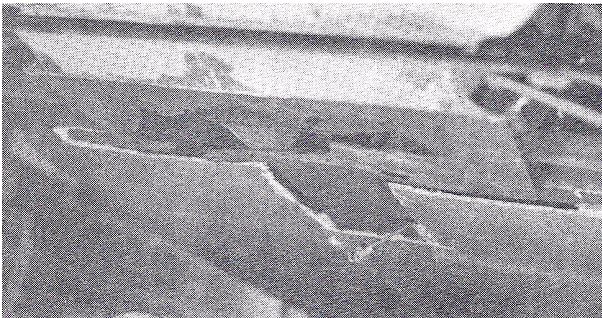Source: Lotus West
Author: James Scherer
Date:
Title: ONE RUSTY EUROPA
LW# 54BI080
Fiberglass cars don't rust, right? Wrong: A case in point is my Europa S1. The photo is of the front underside of the car between the wheels; the anti-sway bar runs across the top of the picture, the disconnected clutch cable is hanging down. Sl's have wrap-around bodies that are bonded and riveted to the frame, and after cutting away the fiberglass that is what I saw - yes, it was quite a shock: A little bit of poking revealed that the entire bottom of the box beam between the suspension pick-up points (cross beam) and about eight inches down the center beam were completely rusted away as were the metal portions of the floor on both the driver's and passenger's sides (the pedal assembly bolts into this on the driver' s side), and about the first two to three inches of the vertical section on both the driver's and passenger's side of the cross beam's side that faces into the cockpit. In fact I first got onto this problem by pulling up the felt on the passenger's side floor and discovering that the metal section of the floor there was rusted through to the fiberglass that forms the underside of the body.

After knocking, sawing, cutting, grinding, and filing my way to solid metal (lots of fun) I cut and bent up replacement pieces, about 15 in all, out of 16 gauge steel. 16 gauge steel happens to be a sixteenth of an inch thick, which is just slightly thicker, it seems, than the steel out of which the frame is made. These pieces were located by sheet metal screws, bolts, and rivets and welded into place (a $60 Job). The result is a front end that is much stiffer than I think it originally was.
After the metal was welded in, I decided to fiberglass in the underside of the car - bonding the fiberglass directly to the metal; polyester fiberglass resin makes a very, very tough bond with bare metal. There seems to be a problem in a number of places where the body was originally bonded to the frame - it was bonded to the painted frame and did not stick well at all, allowing water in between. To finish things off I bolted a removable aluminum sheet to the underside to prevent stones, etc. from cracking the fiberglass. I plan to remove this at least once a? year to see that all is well. The whole Job only took three weeks (a great way to spend your vacation) - an ounce of prevention is worth at least two and a half tons of cure!
This entire fiasco resulted from two problems: l) Water (and in upstate New York, salty slushy water in the winter) leaking into the beam through inadequately sealed holes in the front cross beam that were intended for the right-hand drive set-up hydraulic cylinder and steering column - I had sealed one but missed the other (ouch!), and my seal over the hole in the beam for the actual steering column was leaking at the bottom unbeknownst to me. 2) The fiberglass underbody had been cracked by a stone or whatever, and since the body was originally riveted and not bonded to the frame under the car, this allowed water to get in between the underbody and the bottom of the beam. Thus the beam was rusting from the inside out and the outside in! The second problem could not affect Europa S2's and TC's because of their different body configurations. However, they may be susceptible to the first problem. I've never looked closely at the cross beam on an S2 or TC, but it might be worth your while to check this out.
One positive outcome of this whole thing was the discovery that removing all the foam rubber pieces from the box beam and leaving out the front plug creates a wonderful ventilation system. At about 50 mph it blows off the arm rest cushion behind the shift lever. Since I haven't yet sealed the real and RHD brake pedal and steering column holes on the side of the-cross beam facing the cockpit, a nice blast of fresh air hits your feet. In addition I removed the rubber grommet that half-heartedly sealed the shift linkage's exit from the center beam so that engine compartment ventilation is increased, too. Last but not least the air moving through the beam will keep it dry. It would be possible to make a cable-operated door so that the opening that the front plug originally sealed could be closed off in wet and/or cold weather; and perhaps a two-tiered arm rest cushion with air vents on the first level and a cushion on the second.
James Scherer Ithaca, NY